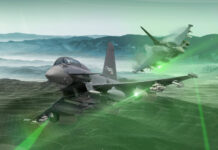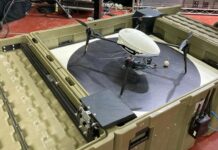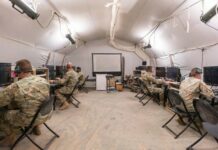Battlefield electromagnetic deception is a vital means to sow doubt into hostile decision-making, and force enemies to divide their assets; tactics that are at the heart of the Spartacus initiative.
The United States Army’s First US Army Group, better known as FUSAG, was a formidable outfit: FUSAG contained two armies, the British 4th and the US 14th. These two formations contained four corps and three independent divisions between them. Deployed across eastern and south-eastern England, FUSAG had an ostensibly simple, but major, objective. The force would invade western Europe across the Pas-de-Calais, the narrowest part of the Channel between the United Kingdom and France. At a mere 33 km (17.8 NM), this route made sense. It was the quickest way for the Allies to attack the western flank of Fortress Europe.
![A dummy Sherman tank, of the type used by FUSAG. [US National Archives]](https://euro-sd.com/wp-content/uploads/2025/05/Dummy-Sherman-tank_US-National-Archives-Kopie-1024x693.jpg)
FUSAG was part of a larger deception campaign mounted by the Allies to confuse their enemy regarding the likely shape of the invasion and its potential location. The First US Army Group was formed as part of Operation Quicksilver, a major component of the wider Operation Fortitude deception effort, which had six distinct parts: Quicksilver-1 focused on disseminating the existence of FUSAG through the double agent network. Quicksilver-2 was the creation and transmission of the fake radio traffic which would be expected to accompany a formation of this size preparing for attack. Quicksilver-3 focused on creating fake materiel and bases in FUSAG’s supposed staging areas in England. Quicksilver-4 would see the allies performing attacks against targets in and around the Pas-de-Calais to prepare the battlefield for FUSAG’s arrival across this stretch of water. Quicksilver-5 would show preparations such as landing craft embarkation performed in and around Dover on the northwestern coast of the Pas-de-Calais. Quicksilver-6 used night lighting to simulate the appearance of FUSAG working all hours to ensure that preparations were ongoing. FUSAG did not disappear once Overlord got underway. Instead, the deceptions continued into September 1944, three months after the invasion had commenced, to convince Berlin that the events in Normandy were but a side show. It was imperative to convince the German High Command that the Allies’ ‘Schwerpunkt’ (point of main effort) was still the Pas-de-Calais.
Fake it ‘til you make it
Using radio traffic for deception has never gone out of fashion as a tactic, as it has much going for it. Firstly, it is relatively inexpensive from a personnel and equipment perspective to achieve. All you need are a few radios to move false traffic between them, and personnel to draft and disseminate this. False traffic can be used for elegant double-bluffs. Such deception can be transmitted on protected, encrypted channels. Should the enemy be successful in breaking into this traffic, they may feel they have stumbled on an intelligence goldmine. Mixing fake and real traffic hands the enemy a dilemma: Which traffic should be distrusted and which should be ignored?
![Tracking down hostile radios provides valuable intelligence on enemy force disposition and movement, but are the signals real or fake? [USMC/Pfc Bishop Williams]](https://euro-sd.com/wp-content/uploads/2025/05/Marine-Radio_USMCPfc-Bishop-Williams-Kopie-1024x683.jpg)
As the FUSAG plan underscored, radio traffic can be simulated to create entire army-size formations with all their attendant and complex tactical networks and backhaul trunk communications at the operational level. Moreover, fake traffic does not need to be confined to voice communications. Land forces are as reliant, if not more so, on data, thanks to digital command and control (C2) and battle management systems. Fake zeros and ones can be as devastating in the discord they can sow as deceptive radio chatter. Mixing fake and real traffic on the battlefield creates an additional problem: Electronic warfare (EW) cadres use communications intelligence (COMINT) to locate and identify troops and deployments on the battlefield. Find a radio and you find a soldier, as the adage says. You may also find a platform, weapons system, sensor or base, given the preponderance of radio connectivity not only within armies, but all military forces.
Identifying a radio’s signal parameters can tell you a lot about that transceiver, and hence a lot about the user and/or asset it equips. Perhaps an electronic support measure (ESM) equipping a COMINT unit has detected a cluster of signals spread over an area of roughly 1 km2 (0.38 square miles). The signals are transmitting on frequencies of between 2.4–2.4835 GHz. The ESM’s antennas triangulate the source of the transmissions, indicating they are around 7 km (4.4 miles) away. Having ascertained the frequencies, the ESM determines the signals have a strength of around -114 dB when they arrive at the COMINT antennas. An accompanying signal on a frequency of 157 MHz with a received signal strength of -108 dB has also been detected. The COMINT cadres will be able to deduce by ascertaining the frequency, geographical concentration of the signals and their strength that they have, with some degree of confidence, detected a squad of troops using their Personal Role Radios (PRRs). The single 157 MHz signal seems to be from the squad commander’s handheld radio. The fact that the signals are mobile and comparatively spread out indicates that that the soldiers have dismounted and are moving. Matching a signal’s characteristics provides a good indication of who, or what, is using a radio to transmit these signals. All this information is ascertained without even needing to break into the actual radio traffic.
![USMC logo for the Signals Intercept and Electromagnetic Warfare Course, Alpha Company, 1st Radio Battalion. Battlefield signal interception and deception have only increased in importance with the adoption of networked warfare. [USMC/Sgt Amelia Kang]](https://euro-sd.com/wp-content/uploads/2025/05/SIGINT-and-EW-Course_USMCSgt-Amelia-Kang-Kopie-791x1024.jpg)
The PRRs, and the single handheld, were not radios at all. They were decoys transmitting similar signals mounted on small uninhabited ground vehicles moving in patterns indicative of dismounted soldiers. Time and treasure have been wasted on a deployment that never occurred. To make matters worse, while this fictitious unit was being engaged, an actual dismounted tactical action was happening nearby, but it was never noticed. Those latter troops exhibited exemplary emissions control (EMCON). Robust EMCON ensured that radios were never used and the COMINT cadres took the bait.
I’m Spartacus
Deception clearly provides significant tactical benefits, and hence potential tactical advantage. This has not been lost on the United Kingdom Ministry of Defence (MoD), which has launched the Spartacus programme, with the ministry’s Defence and Security Accelerator (DASA) responsible for the programme. In its own words, “DASA finds and funds exploitable innovation to support UK defence and security quickly and effectively.” DASA’s vision is “to have strategic advantage through the most innovative defence and security capabilities in the world”. The organisation is backing the Spartacus initiative developed by a UK-based consultancy company called PhoenixC4i. The company says that Spartacus “provides commanders with the ability to mimic C2 systems, increasing uncertainty as to where the true target is”. As well as mimicking C2 radio emissions, Spartacus can be used to generate multiple emitters, which could be deployed in such a fashion as to replicate the locations of radios typically used by deployed land formations.
![The basic constituent parts of the Spartacus architecture are shown here on this workbench during a British Army exercise. The system uses relatively little in terms of hardware. [PhoenixC4i]](https://euro-sd.com/wp-content/uploads/2025/05/Spartacus-1-PhoenixC4i-Kopie-1024x768.jpg)
![Spartacus can be used for an array of electromagnetic deception tactics from simulating the radio traffic and electromagnetic signature of a battlegroup headquarters to mimicking specific tactical actions. [PhoenixC4i]](https://euro-sd.com/wp-content/uploads/2025/05/Spartacus-2-PhoenixC4i-Kopie-1024x768.jpg)
Decoy technologies have come a long way since the days of FUSAG. Nonetheless, the architects of that brilliant deception would instantly recognise the principles at play in Spartacus. As history shows, fooling your adversary can sometimes pay unimaginable dividends.
Dr Thomas Withington

![Dummy Sherman tank_(US National Archives) Kopie A dummy Sherman tank, of the type used by FUSAG. [US National Archives]](https://euro-sd.com/wp-content/uploads/2025/05/Dummy-Sherman-tank_US-National-Archives-Kopie.jpg)






